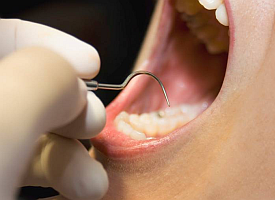16 June 2014. A spin-off company from Kings College London in the U.K. is developing a technology that makes treating tooth cavities a painless electrical process. Reminova Ltd. — located in Perth, Scotland — was founded earlier this year and is led by two Kings College dental faculty, Nigel Pitts and Chris Longbottom, who serve as the company’s chairman and chief technologist respectively.
Tooth decay is among the world’s most common health problems, which affects people with teeth at any age. Bacteria in the mouth accumulate into a biofilm that forms small holes in the hard outer layers of teeth. The subsequent bacterial decay breaks down minerals in the teeth, such as calcium, eventually producing cavities. Current treatment methods require drilling the tooth to remove decayed portions, then filling the drilled-out area with a restorative material, such as amalgam, resin composite, or gold.
The techniques invented by Pitts and Longbottom, known as electrically accelerated and enhanced remineralization, harnesses an electrical current to reverse the process and restore the mineral composition of teeth lost through decay. After a preparation treatment, the tooth is submitted to a low-power electrical signal that sends the minerals into the decayed portion of the tooth to repair the damage. The company says the electrical current is lower than that used today in dental procedures, such as checking nerves or pulp, and not felt by the patient.
Reminova is the first spin-off company from the college’s Dental Innovation and Translation Centre that itself started in January 2013. The company is aided by Innova Partnerships, a Scottish life sciences incubator that also provides an interim CEO and chief operating officer.
“The way we treat teeth today is not ideal,” says Pitts in a university/company statement. “When we repair a tooth by putting in a filling, that tooth enters a cycle of drilling and re-filling as, ultimately, each ‘repair’ fails.” Pitts adds that, “Not only is our device kinder to the patient and better for their teeth, but it’s expected to be at least as cost-effective as current dental treatments.”
Reminova expects to have the process refined within three years, where it can be provided in dental offices and clinics.
Read more:
- More Efficient Growth Factor Delivery Technique Devised
- Wireless Power System Invented for Miniaturized Implants
- Challenge Seeks Fluoride Activity, Disposition in Brushing
- Bio-Gel Designed to Transform into Precursor Tooth Material
- Biotech, University to Partner on Bone Regeneration Trial
* * *


 RSS - Posts
RSS - Posts
You must be logged in to post a comment.